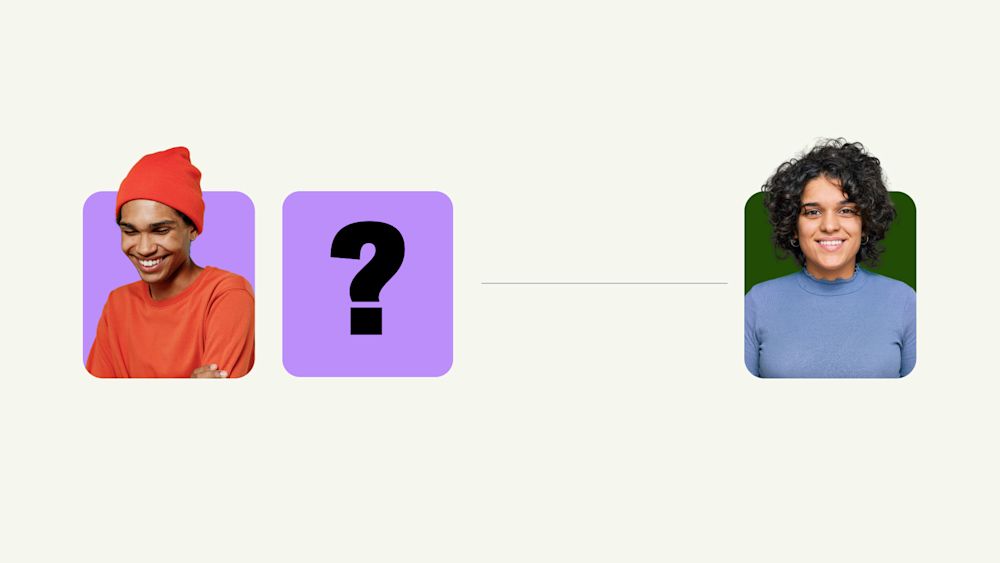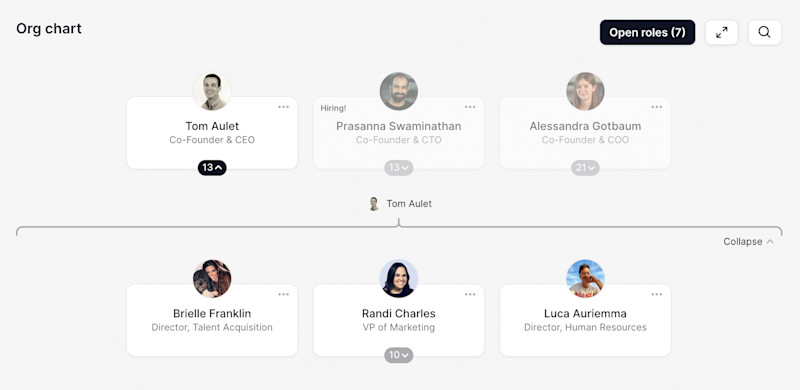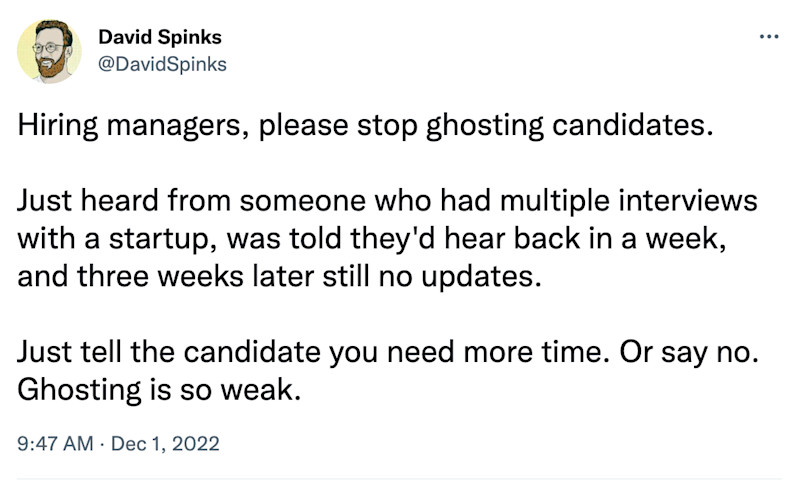Make or Break Factors in the Candidate Experience, and Your Employer Brand
- As a talent acquisition expert, you’ve seen every career path under the sun. Can you tell us about your own?
- Did moving from an agency to in-house talent acquisition change your perspective on employer branding?
- What are the biggest mistakes to watch out for in employer branding?
- So, if trust is a make or break factor for an employer brand, what's make or break for the candidate experience?
- Speaking of, how did Ergatta’s last funding round affect your hiring strategy?
- How did you prioritize roles with such an ambitious hiring strategy?
- Which candidate experience and hiring metrics do you track to measure success?
- You’ve been using The Org for about a year. Has it filled any gaps in your workflow?
Table of contents
We tapped Brielle Franklin, Director of Talent Acquisition at Ergatta, for her insights on hiring at a high growth startup, building entire teams and departments from the ground up, and crafting a candidate experience designed to hit ambitious hiring targets off the heels of Series A funding.

Ergatta is challenging the way at-home fitness looks and feels with game-based connected rowers designed for the living room — and having closed a $30M Series A round last April, Director of Talent Acquisition Brielle Franklin is responsible for investing in the company’s most important asset: their people.
We had the pleasure of picking her brain once again, this time about leading talent acquisition at a high growth startup, and how she crafted a masterful candidate experience designed to meet ambitious hiring goals off the heels of a hefty Series A round.
As a talent acquisition expert, you’ve seen every career path under the sun. Can you tell us about your own?
To make a long story short, I grew up 100% certain I’d become a doctor but developed some reservations after pre-med. So I had a full blown quarter life crisis and wound up back at the drawing board. I first came across the agency I spent the majority of my career at by googling the word “jobs”, and I approached them thinking they could help me find one as a 21 year old college student whose only work experience was in hospitals. Mind you, it was an executive search firm.
They responded to my emails nonetheless, and I quickly realized I didn’t want them to find me a job even if they could — I wanted to work alongside them. They needed some convincing, but I absolutely loved it and stayed on the agency side until the summer of 2020. That’s when my day to day outreach led me to my current manager, Tom, Co-founder and CEO of Ergatta.
A few months later, I left the agency and moved in-house to build Ergatta’s talent acquisition department from the ground up.

Did moving from an agency to in-house talent acquisition change your perspective on employer branding?
To be honest, I didn’t think about the term “employer brand” very much on the agency side — what I did think about was who I knew at the company, and whether or not I trusted and respected them to gauge the employer’s reputation. That’s really the essence of employer brand in hindsight, but at the time I viewed it only through the external lens of talent acquisition, and why a candidate should want to work at my client over another company.
Since moving in-house, I’ve learned that employer branding is so much more than an external process. While that’s a crucial part of it, employer branding isn’t just about hiring — it touches nearly every aspect of the business from engagement and retention, to influencing sales and increasing business value.
In other words, a strong external employer brand starts from within.
What are the biggest mistakes to watch out for in employer branding?
Saying what you’re not to explain what you are. It’s never a good idea to shape your identity relative to competitors — your employer brand should stand on its own.
Making assumptions based on your consumer or business brand. Don’t assume that a strong consumer brand automatically strengthens your employer brand.
Tailoring employer brand messaging to what candidates want to hear. They do their research and can easily sense a disconnect between what you say and what others say — no need to flaunt all of your business’ challenges to potential talent, but honest answers to their questions go a long way.
Overlooking former employees in your narrative. They’re a pivotal piece of your employer brand story, and can be your biggest advocates or detractors — especially for startups just beginning their employer branding journey.
Simply put, employer branding is a genuine reflection of your reputation among the workforce, both internally and externally — so anything that compromises your trustworthiness can be considered an employer brand faux pas.
So, if trust is a make or break factor for an employer brand, what's make or break for the candidate experience?
Communication and authenticity. If someone is investing their time in interviewing with your company, you owe them the courtesy of keeping them informed on where things are, even if it’s a non-update update.

I also feel strongly about providing personalized feedback, especially when it’s with someone who made it far into the interview process before being passed over. It’s not always comfortable, but if it can set them up for success in future interviews, it’s the least I can do. I’ve had enough candidates thank me for the feedback I gave them when letting them know we chose another candidate for the role that I actually have a dedicated folder in my inbox for those emails.
But a positive candidate experience definitely begins with a strategic approach to hiring to avoid wasting candidates’ time. Before even considering interviewing for a role, extensive role scoping (and re-scoping) and calibration exercises should be done to make sure the job description translates to actual candidate profiles.
The idea is to use those profiles, and not real people’s time, to effectively calibrate.
Speaking of, how did Ergatta’s last funding round affect your hiring strategy?
My agency background helped quite a bit. We’d been told by several trusted advisors that hiring our entire executive team in just one quarter — in the hottest candidate market we’d ever encountered — would be impossible without hiring a retained search firm. But the first thing I did was make the decision to not use outside firms.
It was a bold move, but I felt strongly that if we failed to make these pivotal executive level hires, or hired leaders that our future team wouldn’t respect or connect with, we’d be setting ourselves up to fail. People create the culture, culture doesn’t create the people — so to really get it right, you need to vet for values alignment and personality types that will work well cross functionally.
It’s like a big puzzle where you don’t yet have all the pieces.
How did you prioritize roles with such an ambitious hiring strategy?
Our first approach to hiring prioritization was to rank jobs by level of impact and urgency from 1-10.
Impact meaning, is the absence of this role causing a bottleneck?
- 10: Key projects are stuck until we get this domain expertise
- 5: Not having this role will cause a problem in the future
And urgency meaning, how soon do we see that bottleneck occurring?
- 10: The bottleneck is already occurring
- 7: In the next month
- 5: In the next 2-3 months
- Under a 4: We can delay hiring unless there’s a compelling reason to start sooner
It was effective to an extent, but naturally all of our hiring managers ranked their open roles as a 10 for both impact and urgency. So that’s when we asked them to put their money (or in this case, time) where their mouth was, and commit upfront to a two week window where they’d prioritize interviews for their open roles above all else. And it came down to their bandwidth.
We wanted to avoid the classic candidate experience pitfall where applicants invest time and energy, and are genuinely excited about the prospect of working with us — only to face a painful bottleneck from poor planning on our side.
When we asked our hiring managers to commit to a two week window where interviews would be their top priority, they had to get honest with themselves. If they were traveling or had a big deadline coming up, we’d postpone the search until the hiring manager could prioritize interviews — without any lapses in the process.
As important as those prioritized roles were, we didn’t want to compromise on candidate experience. Because every single candidate interaction is a reflection of our employer brand.

Which candidate experience and hiring metrics do you track to measure success?
Time to fill is a metric that most everyone measures, but it can be subject to outside variables like counter offers or another company promising a salary that we can’t beat.
I think “time to decide” is a better metric for evaluating how strong our interview process is. If we’re not confident in our decision to move forward with a candidate and need to see more people in order to achieve that level of confidence, it indicates that we haven’t properly vetted the people who made it through final rounds.
That’s a failure to plan.
You’ve been using The Org for about a year. Has it filled any gaps in your workflow?
We’re actually in the process of redoing our employee profiles to close the gaps in our workflows that The Org is uniquely positioned to address. One of the challenges of working at a high growth startup, regardless of whether or not you’re hiring remotely or in person, is understanding how each role works within and across departments.
We grew from 10 to 55 employees in a short amount of time, and the way you communicate and manage internal knowledge has to change as the team grows. With so much going on and new hires starting so frequently, we wanted to find a way to streamline important information across the company and create our version of an intranet.
The biggest focus for that initiative was helping new team members navigate every person’s role and how it interacted both within and across different departments. We wanted to highlight what projects each person owns, as well as what skills they have at their fingertips to solve problems on their team and beyond.
The Org allows us to address that problem by adding dynamic profiles — which we now call “User Manuals” as a nod to Ergatta’s product and customer experience — full of professional and personal insights about each team member — and it’s had positive ripple effects beyond our internal operations and knowledge management.
Our VP of Product was among the first to share his “User Manual”, which was such a valuable tool that we made it part of our onboarding process and added it to each team member’s profile on The Org. Reading about each team member’s origin stories, quirks, pet peeves, and how they best receive feedback (to name a few) has fundamentally changed the way I work with each hiring manager and approach scaling their team.
Thanks so much to Bree for sharing her experience and expert insights with us. To learn more about Ergatta, check out their Company Page on The Org.
Get in front of millions of visitors and job seekers.
- Showcase your company culture to a vast community of professionals
- Host your team on a free org chart to keep employees aligned
- Post jobs on our free job platform for high growth startups
In this article


The ORG helps
you hire great
candidates
Free to use – try today
